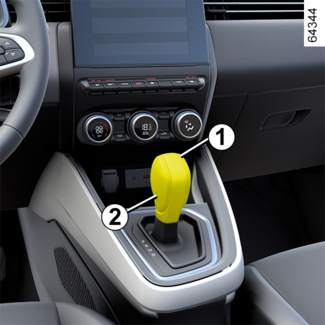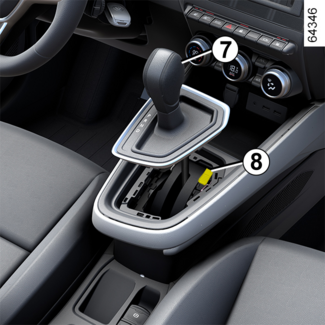Automatic gearbox
Automatic gearbox
Selector lever 1

P: parking
R: reverse gear
N: neutral
D: automatic mode
L: "Low" mode (depending on the vehicle)
B: forward gear with increased regenerative braking (depending on the vehicle)

The 3 display on the instrument panel indicates the gear lever position engaged 1.
Note: press the 2 button to:
- exit P position;
- change from D, L, B or N position to R or P position;
- change from D position to L or B position.
Operation
With the vehicle stationary and the selection lever 1 in P position, start the vehicle.
On the E-tech full hybrid version, the READY message appears on the instrument panel.
To move out of P position, you must press the brake pedal before pressing the unlocking button 2.
With your foot on the brake pedal (warning light 4 on the display off), move out of P position, release the unlocking button 2 and engage D position.
Only engage the lever in D or R position when the vehicle is stationary, with your foot on the brake and the accelerator
pedal released.
Tip
The READY warning light on the instrument panel indicates that the E-tech full hybrid system is in operation and ready for driving IGNITION-STARTER SWITCH ON A VEHICLE WITH KEY., IGNITION-STARTER SWITCH ON A VEHICLE WITH CARD.
Driving in automatic mode
Set the lever 1 to D position.
In the majority of driving conditions, you will no longer have to use your gear lever:
the gears change automatically, at the right time, to a suitable engine speed because
the automated system takes the vehicle's load, road profile and the selected driving
style into account.
Economical driving
When driving, always leave the lever in position D, keeping the accelerator pedal lightly depressed to ensure automatic gear changes
at a lower engine speed.
Accelerating and overtaking
Depress the accelerator pedal briskly and fully (so that it goes beyond the kickdown
point).
This will enable you to change down to the optimum gear within the engine range.
Driving in mode B
This mode enables driving with greater regenerative engine braking.
When releasing the accelerator pedal, the vehicle uses regenerative braking to slow
down.
Thus the electric motor generates a higher electrical current which enables the traction
battery to be recharged.
In B mode, the regenerative braking will be reduced if the accumulator is cold or completely
charged.
WARNING
The engine brake should under no circumstances be used as a substitute for the brake
pedal.
Gear change paddles 5 and 6

Depending on the vehicle, the gear change paddles 5 and 6 can be used to change gear when the lever is in D position.
- 5.
- Change to a lower gear.
- 6.
- Change to a higher gear.
The P, N, L, R and B positions cannot be engaged using the paddles.
Driving in manual mode
When driving in D position, you can switch to manual driving mode using paddles 5 and 6 on the steering wheel.
Depending on the vehicle, two manual driving modes are available:
- a "temporary" manual mode which can be used to force a gear change by a brief press on one of the paddles. Driving mode D and the gear engaged will appear on the instrument panel.
Note: the gearbox returns to automatic mode D if the gear engaged is not optimal or if the paddles have not been used for a certain
amount of time.
- a permanent manual mode activated by pressing and holding either of the paddles. The driving mode M and the gear engaged will appear on the instrument panel display.
Note: return to automatic mode by pressing and holding the right-hand paddle. Automatic
mode D is displayed on the instrument panel.
In all situations:
- to shift down through the gears, press the left-hand paddle;
- to move up through the gears, press the right-hand paddle.
Note: depending on the display, the + and ˗ or  and
and  indicators will suggest moving up or down a gear.
indicators will suggest moving up or down a gear.
Special cases
In certain driving conditions (resulting in, for example, engine protection, activation
of the electronic stability control (ESC), etc.), the automatic system may change the gear automatically.
Likewise, to prevent incorrect manoeuvres, a gear change may be refused by the automatic
system: in this case the gear display flashes for a few seconds as a warning.
Tip
When facing uphill, to remain stopped, do not keep your foot on the accelerator.
Risk of overheating the automatic gearbox.
WARNING
Check that the indicator light P on the instrument panel is activated before leaving the vehicle.
Risk of loss of immobilisation of the vehicle.
Special circumstances
If the road type or weather conditions (steep uphill slopes, sudden downhill slopes, deep snow, sand or mud) make it difficult
to stay in automatic mode, depending on the vehicle, it is advisable:
- on vehicles equipped with steering wheel paddles: to switch to manual mode using the paddles. This will prevent the "automatic gearbox" from changing gears repeatedly when driving uphill, and permit engine braking on long descents.
- on vehicles not equipped with steering wheel paddles: use "Low" mode to enable, at a speed below 31 mph (50 km/h), driving on surfaces with low grip (snow, mud, etc.), climbing a slope or engine braking during a hill descent. To do this, set the lever to L position.
Note: in "Low" mode, the variations in engine speed are continuous and the accelerations are more
linear.
To avoid the engine stalling in very cold weather, wait a few seconds before disengaging P or Nposition and engaging the lever in D, R, L or B position.
WARNING
In the event of an impact to the underside of the vehicle (e.g. striking a post, raised
kerb or other street furniture) this may result in damage to the vehicle (e.g. twisted
axle), the electrical circuit or the traction battery.
Do not touch the circuit elements or any fluids or liquids.
To prevent any risk of accident, have your vehicle checked by an authorised dealer.
Risk of serious injury or electric shock and risk to life.
Parking the vehicle
When the vehicle is stopped, move the lever to position P while keeping your foot on the brake pedal: the gearbox is in neutral and the drive
wheels are mechanically locked by the driveshaft.
Ensure that the electronic parking brake is engaged.
Maintenance period
Refer to the maintenance document for your vehicle or consult an Approved Dealer to
check whether the automatic gearbox requires scheduled maintenance.
If it does not need to be serviced, there is no need to top up the oil.
Tip
P position must only be engaged when the vehicle is stationary.
Operating faults
- When driving, if the "WARNING: Check Gearbox" message appears on the instrument panel, it indicates a fault.
Contact an approved dealer as soon as possible;
- when driving, if the "WARNING: Gearbox Overheating" message appears on the instrument panel, stop as soon as possible to let the gearbox cool down and wait for the message to disappear;
- breakdown recovery of vehicle fitted with an automatic gearbox TOWING: BREAKDOWN.
WARNING
For safety reasons, do not switch off the ignition before the vehicle has come to
a complete standstill.

When setting off, if the lever is stuck in P when you press the brake pedal (e.g. battery fault), it is possible to manually release
the lever to unblock the drive wheels.
To do this, unclip the base of the gaiter and press the push button 8 while simultaneously pressing button 7 on the lever to unlock the lever and shift to N position.
Contact your approved Dealer as soon as possible;